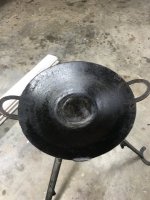LMichaels
TVWBB 2-Star Olympian
Honestly something you'd think I should know by now LOL.
We bought our daughter a Lodge cast iron pan so she could make skillet meals. (she's not a good cook). She calls me in a panic the other day. The pan is rusty. So I instructed her how to handle it and she was able to make her meal and I promised her I would strip it and reseason it. So I stripped it down nicely. And since I had some bacon drippings from breakfast I did the first wipe down with it. By, getting the pan hot on the stove, and wiping down to a very thin shine really well.. Then into 350 oven for one hour and allowed to cool in the oven. Took it out for the second treatment and noticed that it felt "sticky". My plan was (and what I did so far), was to repeat the heat up on stove top, wiped it well with about a tsp of avocado oil. Now it's back in the oven at 350. Should I have not used the drippings? Am I stuck fully stripping it down again?
We bought our daughter a Lodge cast iron pan so she could make skillet meals. (she's not a good cook). She calls me in a panic the other day. The pan is rusty. So I instructed her how to handle it and she was able to make her meal and I promised her I would strip it and reseason it. So I stripped it down nicely. And since I had some bacon drippings from breakfast I did the first wipe down with it. By, getting the pan hot on the stove, and wiping down to a very thin shine really well.. Then into 350 oven for one hour and allowed to cool in the oven. Took it out for the second treatment and noticed that it felt "sticky". My plan was (and what I did so far), was to repeat the heat up on stove top, wiped it well with about a tsp of avocado oil. Now it's back in the oven at 350. Should I have not used the drippings? Am I stuck fully stripping it down again?

